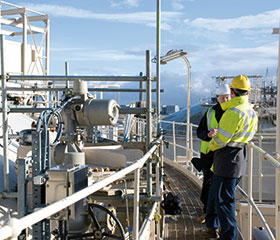Honeywell optimises pipeline operations in China
September 2015
System Integration & Control Systems Design

Honeywell Process Solutions has announced that its technology will help improve operations for China’s long-distance Guangxi liquefied natural gas (LNG) high-pressure pipeline.
A key strategic project of Sinopec and Guangxi Zhuang Autonomous Region, the Guangxi LNG pipeline will play a critical role in optimising China’s energy structure and meeting the demand for natural gas in Guangxi. The project will use HPS gas measurement equipment and software to measure the flow and pressure in the pipeline.
“We are able to draw upon our experience in long-distance, natural gas high-pressure pipelines to provide expertise to this essential clean energy project,” said Aldous Wong, HPS vice president, China. “Pipelines have challenges that are very different from processing plants, since you have to manage an operation that is hundreds or sometimes thousands of miles long. Measurements such as flow and pressure must be accurate and immediately accessible to keep the pipeline operating at maximum efficiency.”
The pipeline should be completed later this year, and will have a capacity of 8 billion cubic metres of LNG per year, and a total length of more than 200 kilometres. This pipeline will be part of a network that transports natural gas and LNG from as far away as Kazakhstan to China. HPS technology is already being used on all three of the 1800 kilometre central Asia to China pipelines, as well as the 9000 kilometre west to east pipeline.
The integrated gas measurement technologies provided by Honeywell includes computer software and sensors that measure flow, temperature, pressure and other indicators that are critical to maintain optimum performance throughout the pipeline. These include:
• Ultrasonic flowmeters, which measure natural gas for custody transfer applications, which require high reliability, excellent metering certainty and repeatability.
• Flow computers, which can perform parallel calculations of compressibility according to all established methods, including GERG 88 S, AGA 8 and AGA NX 19.
• SmartLine temperature and pressure transmitters, which deliver value across the entire plant lifecycle. These transmitters reduce initial purchasing costs, provide flexibility for post start-up modifications, and reduce maintenance and inventory costs while providing high accuracy and stability.
For more information contact Boni Magudulela, Honeywell Southern Africa, +27 (0)11 695 8000, boni.magudulela@honeywell.com, www.honeywellprocess.com
Further reading:
It’s a risky business not to challenge standard language
System Integration & Control Systems Design
On the surface, contracts all look alike. Once you’ve seen one, you’ve seen them all, or so it seems. Maybe so, but hidden within the standard language can be language that shifts the other party’s risk to you.
Read more...
Containerised Electrical & Control System Powers Paste Plant in Botswana
System Integration & Control Systems Design
Delivering a complete, containerized solution for a mine’s paste plant in Botswana, this project stands as a model of modern EC&I execution — integrating electrical, control, and automation systems into
...
Read more...
Control system upgrade: Smelting
SAM Systems Automation & Management
System Integration & Control Systems Design
Systems Automation & Management recently completed a major control system upgrade in the smelting industry. The project was delivered on budget and achieved a positive ROI for the client.
Read more...
Gottwald drives upgrade: Ports and harbours
Abacus Automation
System Integration & Control Systems Design
In the ports and harbours sector, Abacus Automation completed a significant modernisation of a Gottwald crane, improving both operational reliability and serviceability.
Read more...
Mining industry upgrade: From ageing systems to maximum capacity
System Integration & Control Systems Design
Iritron recently undertook a major upgrade in the mining sector, focusing on washing and screening plants, jigs, thickeners, tailings, water systems, conveyors and reclaimers.
Read more...
Agogo Integrated West Hub Project: FPSO/subsea offshore Angola
Moore Process Controls
System Integration & Control Systems Design
The Agogo Integrated West Hub project represents a historic milestone in the FPSO and subsea industry, achieving first oil offshore of Angola. This project is the first FPSO deployment since ANPG’s establishment in 2019, and the first major project for Azule Energy since 2022.
Read more...
Integrated Robotics and Control Systems Deliver 45% Production Boost at Aquazania Waters Project and Industry
Process Dynamics
System Integration & Control Systems Design
Project and Industry Process Dynamics designed and commissioned a state-of-the-art Reverse Osmosis
(RO) water purification and automated bottle filling plant for Aquazania Waters in Linbro Park, Johannesburg.
...
Read more...
Project and Industry
System Integration & Control Systems Design
The Sicomp Control System Upgrade focused on modernising a 1985 power generation control system with more than 3 000 I/O points. The plant faced increasing system failures and risk to operational continuity,
...
Read more...
Digital transformation from the edge
DirectLogic Automation
System Integration & Control Systems Design
Edge-enabled PLCs are an accessible and affordable way for most users to collect and create value from use field-sourced data.
Read more...
Powering southern Africa’s industrial evolution for over five decades
Oilpower
System Integration & Control Systems Design
Established in 1974, Oilpower is a recognised name in South Africa’s hydraulic and pneumatic sector. What started as a small, family-run business has matured into a highly structured operation with specialised teams, experienced engineers and a reputation for technical excellence and reliability. Oilpower is celebrating its 50th anniversary this year
Read more...


